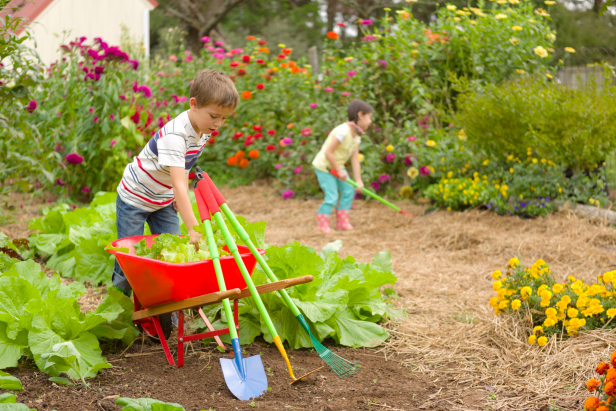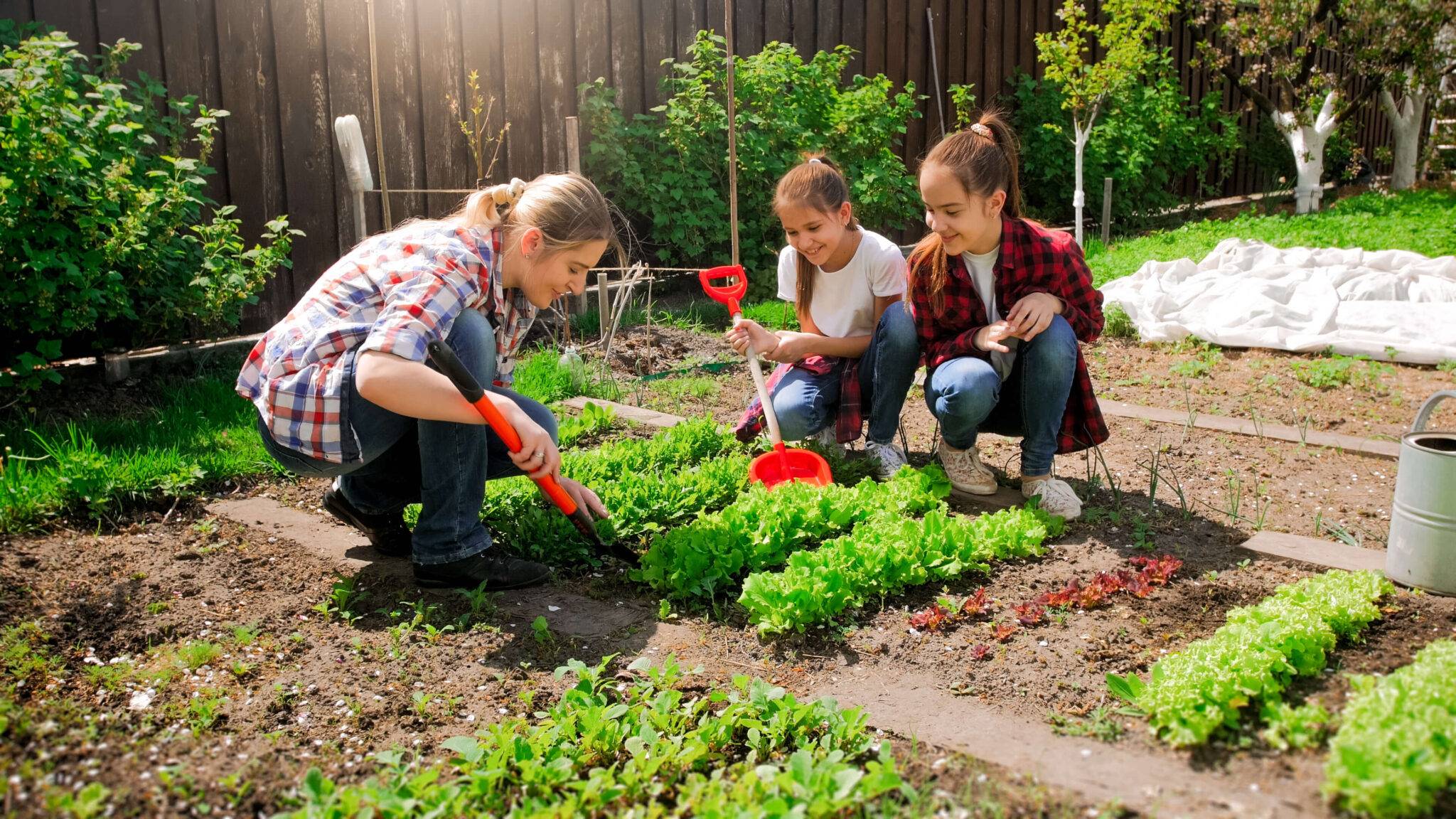Table of Contents
Gardening with kids is an exciting adventure that can develop their green thumb and create a deeper connection with nature.

Why is Gardening with Kids Important?
A healthy and fun activity, gardening affords numerous benefits for children. Here are some reasons why:
- Children learn from growing things. Gardening is educational, giving opportunities for them to develop new skills such as a degree of responsibility, understanding, and confidence.
- Gardening engages all the five senses and encourages healthy eating.
- Gardening develops fine motor skills and is a great physical development activity.
- Gardening reduces stress while improving attention and memory.
- Gardening can be a great family activity, reinforces bonding with children, and creates lasting memories.
- Gardening creates environmental stewards and teaches children the importance of sustainable farming practices.
By gardening with kids, parents help their children develop a love for nature, learn new skills, and have fun doing it. In this guide, we at Omega Pediatrics have compiled 15 effective ways to engage your child in the joys of gardening.

How to Develop Your Child’s Green Thumb
Let’s dive in and explore these fun and educational ways to develop your child’s green thumb!
1. Start small.
Begin by allocating a small garden bed or container specifically for your child’s project. This approach gives them a designated space and ensures a manageable project that they can easily tend to. Provide child-sized tools and equipment that help them feel empowered.
2. Involve them in the planning.
Let your child take an active role in the planning process. Together, explore seed catalogs or visit garden centers to select plants. Discuss the specific care requirements of each plant, helping them understand the unique characteristics of their chosen plants.
Encourage their creativity in designing their garden layout, considering plant heights, sun exposure, and potential planting arrangements. Sunflowers and cherry tomatoes are great choices since they give quick results with minimal effort.
Just remember to choose plants that aren’t only easy to grow and maintain but also align with your child’s interests. Also, consider plants with vibrant colors or unique shapes to capture their attention and curiosity, keeping them engaged and excited through the gardening process.
3. Show them how to sow seeds.
Guide your child through the process of sowing seeds at the appropriate depth and spacing. Seeds need a suitable environment to germinate, including proper soil moisture and warmth. Explain the importance of preparing the soil, soil structure, and drainage.
Discuss the need to follow the seed packet instructions for sowing depth and spacing to ensure optimal growth. Let your kids handle seeds with care and show techniques for placing them in the soil, covering them lightly, and patting the soil gently to ensure good seed-to-soil contact.
4. Demonstrate proper watering.
Teach your child the correct way to water plants by showing them how to water at the base of the plants, aiming for the root zone. Explain that deep, thorough watering is better than light, frequent watering, as it encourages the roots to grow deeper.
Also, emphasize the importance of avoiding overwatering, as it can lead to root rot and other issues. Demonstrate how to use a watering can or hose with a gentle spray attachment to provide the right amount of water.
5. Explain the role of sunlight.
Assist your child in choosing appropriate locations for optimal growth. Teach them the significance of sunlight for plants and their growth. Discuss how plants use sunlight to convert energy through photosynthesis.
Help them identify the best spots in the garden that receive ample sunlight, particularly for sun-loving plants. Explain giving shade and its impact on certain plants. Show how to monitor sunlight exposure by observing the movement of shadows.
6. Discuss plant care.
Teach your child about the basic needs of plants, including water, sunlight, and nutrients. Show them how to care for their plants, emphasizing regular maintenance and providing the necessary resources for healthy growth.
Discuss fertilizers and organic requirements, explaining how they enrich the soil and provide nutrients. Introduce them to natural pest control methods such as companion planting. Demonstrate techniques for pruning, deadheading, and providing support to plants.
7. Discuss the life cycle of plants.
Educate your child about the lifecycle of plants, from seed to seedling, flowering, and eventually producing fruits or seeds. Show examples of different plants at various stages of growth, providing real-life examples to understand plant development.
Introduce germination and how seeds need moisture, warmth, and oxygen to sprout. Demonstrate how flowers develop, leading to fruits or seeds. Engage them in hands-on activities like seed and flower dissection or seed saving to deepen their understanding of plant life cycles.
8. Teach them how to remove weeds.
Transform the tedious task of weeding into an enjoyable activity by turning it into a game. Challenge your child to see who can find and pull out the most weeds, making it a friendly competition while keeping the garden free from unwanted plants.
Also, teach them how to identify common weeds and discuss why it’s important to remove them. Emphasize the concept of weed prevention through mulching or timely removal to maintain a healthy garden ecosystem.
9. Explore beneficial insects.
Foster your child’s interest in the ecosystem by discussing the role of beneficial insects such as ladybugs, bees, butterflies, and earthworms. Explain how these insects contribute to pollination, pest control, and soil health.
Help them identify different beneficial insects and their unique characteristics, including behavior, lifecycle, and interactions with plants. Provide resources like field guides, magnifying glasses, or bug jars to enhance their exploration and understanding of the insect world.

10. Encourage creativity.
Nurture your child’s creativity by allowing them to express themselves in the garden. Let them decorate plant labels with their artistic flair, using colorful markers or paint. Create garden signs together, featuring their designs or messages.
Encourage them to make garden-themed crafts using natural materials, such as pressed flowers, leaf rubbings, or seed art. This encourages their imagination, enhances fine motor skills, and adds a personal touch to the garden space.
11. Harvest together.
Involve your child in the rewarding experience of harvesting the fruits of their labor. Teach them how to determine the right time for harvest, such as when fruits are fully ripened or vegetables have reached an appropriate size.
Demonstrate harvesting techniques and how to use pruning shears to avoid damaging plants. Discuss why timely harvesting is necessary to prevent overripening or seed dispersal. Let them taste their fresh produce right from the garden, savoring the flavors and textures.
12. Expand your child’s knowledge about plants.
Foster a love for reading and learning about plants by dedicating a comfortable space where your child can relax with books focused on plants, gardening, and nature.
Fill the space with age-appropriate books, ranging from picture books to educational guides for young gardeners. Encourage reading about different plant species, gardening techniques, or inspiring stories of environmental conservation.
Whenever possible, consider showing actual plant samples from different regions or climates, expanding their botanical knowledge and appreciation for plant diversity. Take them on trips to botanical gardens or arboretums for exposure to varied plant species and to foster a sense of wonder and curiosity.
13. Establish a routine.
Develop a gardening routine by assigning children specific tasks based on their age and abilities. Establish a schedule for watering, weeding, or monitoring plant growth. Involve them in decision-making, such as when to transplant seedlings or when to start new rounds of planting.
A routine instills a sense of responsibility and discipline in their gardening practice, teaching care, and maintenance. By following a schedule, they develop a deeper understanding of plant needs and the rewards of consistent effort.
14. Foster environmental awareness.
Use gardening to discuss broader environmental topics such as concepts of conservation, sustainable gardening practices, and protecting natural resources. Discuss the impact of human activities on the environment and ways to reduce their ecological footprint.
Introduce them to concepts like composting, water conservation, or creating wildlife-friendly habitats. Understand the relationship between plants, animals, and the environment, emphasizing the role of gardening in promoting biodiversity and a healthier planet.
By nurturing their environmental awareness, you inspire them to become stewards of the earth.
15. Celebrate their achievements.
Acknowledge and celebrate your child’s gardening accomplishments, both big and small. Whether it’s the first sprout breaking through the soil, a bountiful harvest, or simply maintaining a healthy garden, recognize their efforts and express pride in their achievements.
Celebrate their milestones through a garden party or by inviting friends and family to showcase their garden. This positive reinforcement boosts their confidence, nurtures their passion for gardening, and encourages them to continue developing their green thumb.
By celebrating their achievements, you create a sense of fulfillment and joy in their gardening journey.

Foster Your Kids’ Green Thumb
Gardening with kids is a wonderful way to foster their green thumb and deepen their connection with nature. From starting small and involving them in the planning process to proper watering and plant care, each step contributes to their growth as young gardeners.
Encourage creativity, experimentation, and a sense of environmental awareness while celebrating their achievements along the way. So, why wait? Involve your kids in gardening today and embark on a rewarding journey together!
We at Omega Pediatrics promote eco-friendly parenting, where you raise your child to be green! Your child having a green thumb is one way to carry out this parenting technique. If you need more supplemental information on how to raise your child well from a pediatrician’s perspective, feel free to read more of our articles.
FAQ
Why is Gardening with Kids Important?
Gardening with kids is crucial as it teaches responsibility, fosters confidence, engages their senses, encourages healthy eating, and strengthens family bonds while creating environmental awareness.
How to Develop Your Child’s Green Thumb?
Start small, involve them in planning, show them how to sow seeds, demonstrate proper watering and sunlight exposure, discuss plant care, teach them to remove weeds, explore beneficial insects, encourage creativity, harvest together, expand their plant knowledge, establish a routine, foster environmental awareness, and celebrate their achievements.
What are Some Tips for Involving Kids in Gardening?
Allow children to choose plants they like, make it a sensory experience, provide child-sized tools, turn weeding into a game, explore bugs together, encourage creativity with crafts, read books about plants, establish a routine, discuss environmental topics, and celebrate their gardening milestones.
How Does Gardening Benefit Kids?
Gardening benefits kids by teaching responsibility, promoting healthy habits, fostering creativity, enhancing motor skills, reducing stress, improving attention, creating environmental stewards, and strengthening family bonds.
Why is Celebrating Achievements Important in Gardening?
Celebrating achievements boosts children’s confidence, reinforces their passion for gardening, encourages continued participation, and creates a sense of fulfillment in their gardening journey.



